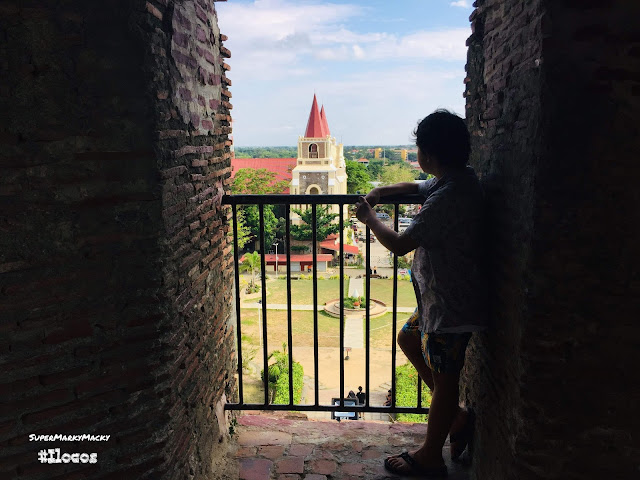From La Union, let's now go north, to Ilocos Region. Hey Super Folks! Are you ready for another travel blog? For another virtual tour of the Philippines? Honestly, I don't know how will I start this, but I guess, perfect timing, yesterday, I was watching one of Nas Daily's vlogs on YouTube, with a title "how Spanish is the Philippines?", well, no doubt, the question is indeed, fit for this blog post. Buckle up! We're heading to our next destination and allow me to be your tour guide.
The Saint Augustine Church or Paoay Church
So, welcome to Ilocandia! This is the stunning Paoay Church, our first tourist attraction for today, we're in the municipality of Paoay, in the province of Ilocos Norte. In Southeast Asian countries like Thailand and Cambodia, there are splendid temples where history buffs can visit to see the marks of the past. On the other hand, in the Philippines, what we have are Roman Catholic churches, one of the best answers to the question, "how Spanish is the Philippines?", they are good story-tellers and reflections of the past. Amazing churches like the Manila Cathedral, Taal Basilica, Daraga Church, Miag-ao Church, and the picture above, the Saint Augustine Church.
La Paz Sand Dunes
Also known as San Agustin Church of Paoay. Our country is by and large Catholic due to the influence of the Spanish colonial era. For more than 300 years, Spain didn't only shape the nature of religion in the pre-colonial Philippines and ethnic history but also influenced many of our country's churches. Paoay church is Iglesia de San Agustin de Paoay in Spanish. One of the most popular and oldest churches in the Philippines, completed in 1710. It is declared as a National Cultural Treasure by the Philippine government in 1973 and included in the list of UNESCO World Heritage Site's collective group of Baroque Churches of the Philippines in 1993.
An "Earthquake Baroque" church, its unique architectural style is a reinterpretation of European Baroque by Filipino and Chinese craftsmen, adapted to the seismic condition of the country. Next tourist attraction is? If African continent has Sahara and Arabian Desert in Western Asia, in our country, we have La Paz Sand Dunes, one of the most visited tourist spots in the city of Laoag, found in the coastal village of Barangay La Paz, which lends the site its name. The area is estimated to be 85 square kilometers long coastal beach and desert area. It is said that the sand dunes of Ilocos were created by the interaction of the wind, sea, and river that together cause erosion and deposition.
Kapurpurawan Rock Formation
Locals call it "Bantay Bimmaboy" because of its shape which resembles that of pigs. Furthermore, it is called the "Desert of the North" because of its popularity when it comes to shooting locations for famous films both inside and outside the country, like the FPJ's "Ang Panday" movie. Talking about God's creations, one perfect example is the Kapurpurawan Rock Formation or the "The White Rock" in the town of Burgos, Ilocos Norte. Our third tourist spot.
Unquestionably an art of nature, tourists can see breathtaking rock formation by the beach. A creamy white rock surface sculpted by natural process of sedimentation. The root word "puraw" from its name is an Ilocano word which means "white" because of the alabaster rock formations.
"In front of the rocks is the view of the Bangui Bay's crystal blue waters and the visually appealing sight of the waves dramatically thumping against the limestone formations makes the scene a picture perfect moment in every way possible."-primer.com.ph
Burgos Wind Farm
A neighboring attraction is the earth-friendly Burgos Wind Farm, it's the second wind farm built in the province of Ilocos Norte and the largest wind power project in the Philippines and Southeast Asia. According to firstbalfour.com, the wind farm now generates about 370 gigawatt-hours of energy and avoids an estimated 200,000 tons of carbon emissions annually. Cool, right?
The Great Ancestral Marcos Mansion
How's our virtual tour? Are you enjoying it? Relax, there's more. It's time to visit the Malacañang of the North, a presidential museum in Paoay, Ilocos Norte. It was the residence of the family of Ferdinand Marcos when he was the President of the Philippines.-en.wikipedia.org
Beautiful Painting of Paoay Church
Based from the site primer.com.ph, the house itself was a gift from former First Lady and Representative of the 2nd District of Ilocos Norte, Imelda Marcos to her husband. It was one of the many properties sequestered from the Marcoses after Marcos Sr. was removed from power. It was eventually given back to the Ilocos Norte local government and was re-opened in 2011 as a museum. It has views of Paoay Lake along with well-tendered gardens. It also had its own reservoir designed to collect rainwater. This made the mansion self-sustaining in terms of its water supply.
Classy Painting of Former First Lady Imelda Marcos
A two-story mansion consists of seven(supposedly a lucky number for Marcos) rooms, with each room having a theme of historical events from the Marcos era: Study, Agriculture, Diplomacy, OFW(Overseas Filipino Workers), Culture, Nation Building and Family.-en.wikipedia.org
Peaceful view of Paoay Lake
"The great mansion showcases family memorabilia, especially mementos of Marcos' military service during World War II, his political career, and his 20 years of presidency. There is a display of family photographs and portraits, some 33 life-sized statues of Marcos dressed in variety of outfits, his car license plates from his years as a congressman, and letters that he wrote addressing the Filipinos during his exile in Hawaii."-www.vigattintourism.com
Painting of Former President of the Philippines Ferdinand Marcos Sr.
"10th President of the Philippines"
Moving on, I know that everyone is hungry and tired, let's rest for few hours. Gosh, I really miss traveling. I wish I could also go back to Ilocos after pandemic or next year. These photos were taken last 2019, on our joiners tour, it was my third time doing it. It was summer, Cinco de Mayo, and we only paid PHP 1899(USD 38) per person. My bad, I wasn't able to take pictures of the beach in Pagudpud, only because I woke up late. I didn't even get the chance to swim longer and sunbathe.
Bantay Bell Tower
Our Ilocandia trip was shorter than the educational tour we experienced when we were in college. We really spent more hours inside the van than inside our room in Pagudpud. Second day, we went to Ilocos Sur to visit other historical places like the old historic belfry of the church known as the Bantay Tower. It is said that this served as a watchtower back in Spanish colonial era, it helped in alerting them against invading enemies such as pirates. The word "bantay" means to guard.
It was built in 1591 and named after Bantay town where it is located, also a 10-minute ride away from the city of Vigan. This belfry sits on a hill, it is said that, it was known as Diego and Gabriela Silang's(Philippine heroes) favorite date spot during the 17th century. Getting to the top of the watch tower is easy-peasy, you will not only be greeted by a huge, old bell, but also the incredible panoramic scenery through the windows. Blue clear sky of the dry season, we could see the surrounding towns and mountains of Abra. Obviously, it's another important place to visit, when it comes to the culture and history of the country.
The bell tower also serves today as belfry of the one of the oldest surviving churches in Ilocos region, established in 1590, the Saint Augustine Parish Church, also known as the Shrine of Our Lady of Charity(Shrine of Nuestra Señora de la Caridad).
"The church was heavily damaged during World War II and rebuilding was started in 1950. The restored façade is of Neo-Gothic design mixed with pseudo-Romanesque materials and elements. It is designed to be grandiose and reminiscent of Spanish architecture. It uses materials such as bricks and mud."-en.wikipedia.org
Calle Crisologo
How Spanish is the Philippines? Let me ask myself again. Yes, it's true that the roughly 350 years Spanish influence in the Philippines is unforgettable. It's already in the blood. The Spanish colonial period had left marks on Filipino culture, remnants that last even today. Not only from churches, religion, but also to our last names, usual words in Tagalog, other Philippine dialects, Mañana habit, and many more. Also, major places like the Intramuros in the city of Manila, capital of the Philippines, and the Calle Crisologo of Vigan City, Ilocos Sur. That's our next destination, let's go!
Quite heartbreaking because this place was the last stop of our Ilocandia tour. It was hot Sunday afternoon, unexpectedly, Calle Crisologo welcomed us with colorful fiesta. Festive vibes, smiling people, sound of drums, and joyful folk dancers. It was a busy event.
Century-old houses, cobblestone streets, and "calesas". Tourists will definitely think that that they are like inside a huge time capsule, it will bring them back to the Filipino-Spanish colonial era. We'll find ample ancestral homes of Ilocano descendants that have withstood calamities throughout the centuries and as of today. Some were restored as restaurants and souvenir shops.
To feel more the old Spanish vibe, we rented a "calesa", or the horse-drawn vehicle, a main mode of transportation back in the 18th century. We had a quick sightseeing tour where we visited the famous "Pagburnayan" or Burnay Pottery. We also went to this shop where we bought Bagnet, an Ilocano version of crispy pork belly, and my favorite Vigan Longganisa, a small and garlicky native pork sausage.
Calle Crisologo is also known as Mena Crisologo Street, it was named after the prominent Ilocano poet, playwright, writer, and politician Marcelino "Mena" Crisologo. Random fact, the entire city of Vigan is a UNESCO World Heritage Site.
"Vigan is best-preserved example of a planned Spanish colonial town in Asia. Its architecture reflects the coming together of cultural elements from elsewhere in the Philippines, from China and from Europe, resulting in a culture and townscape that have no parallel anywhere in East and South-East Asia."-whc.unesco.org
Whether you go Sur first or Norte first, these two provinces in the Ilocos Region are deserving. There are interesting towns to visit, not only beach and mountains, but old houses too. One will get to experience another shade of the Philippines. I can say that, these provinces are perfect examples of "old meets new". If you're also a foodie like me, you could try Empanada and Tupig.
At last! We're done with our tour for today, we need to go back to Manila. It's a short trip, not that satisfied? Understandable. We could drive North again next year, if God permits. We would try the midnight at Calle Crisologo, see the Patapat Viaduct, visit the Laoag Cathedral, and swim in Pagudpud. Those activities, oh my Lord, please give us better 2021.
Super thanks for reading. Oops! After you leave me, please make sure to check my YouTube channel.
SuperMarkyMacky Tube




















Comments
Post a Comment